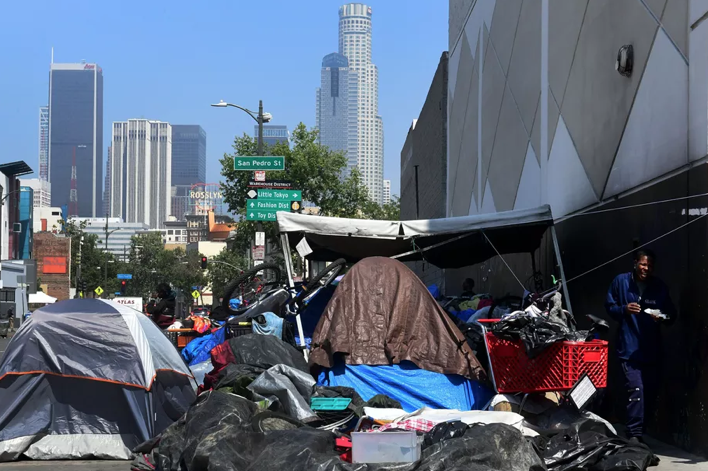NEIGHBORHOOD POLITICS-The new homeless numbers came out earlier this month and they are not pretty.
There are now 41,290 people in the City of Los Angeles experiencing homelessness, a 14.2% rise from last year’s point-in-time count.
This number is almost certainly low as the count rarely captures a significant number of couch-surfers and those who live in their cars or drift from place to place.
On the other hand, efforts to protect the homeless after the onset of the pandemic have probably reduced these numbers, possibly even from the 2019 count. At least for now.
However, we still have more homeless on the streets of Los Angeles – and living in cars, and crashing on friends’ sofas, and camping in the Arroyo – than many American cities.
And next year. . .well, next year we will be contending with the aftermath of the pandemic.
Richard Llewellyn, the Chief Administrative Officer (CAO) for Los Angeles, has the dubious honor of being the point person for the multi-departmental challenge to improve the circumstances of the men, women and children who live unhoused in our City.
The CAO and his staff understand the urgency of finding solutions and nearly every section of his department is focusing on homeless-related matters.
Most of the people experiencing homelessness that the City helps house, stay housed. Eighty-eight percent of the people placed in permanent housing in 2018 have not returned to the streets. In 2019, the rehousing system helped 22,769 people move into permanent housing.
The City’s “A Bridge Home” program saw a 39% increase in the sheltered population, from 8,944 to 12,438. And in 2019, the County placed 18,395 people in interim housing, a 25% increase from the previous year.
The total budgeted for fiscal year 2019-2020 for homeless services and housing was almost half a billion dollars, up 14% over the previous year’s final budget. Over half of this, close to $300 million, was from the voter-approved Proposition HHH bond proceeds.
All of the HHH funding has now been allocated and an $85 million grant from the state is over 90% committed. Nevertheless, in 2019 the number of tents on the streets of Los Angeles continued to increase and the number of homeless by 82,955, even as 52,689 homeless individuals “resolved out” and 22,767 more were placed in housing.
Making these big numbers more comprehensible, approximately 227 Angelenos enter homelessness for every 207 who leave the system.
With the advent of the pandemic and the need to protect those already on the streets from spreading the virus, the cash-strapped City is in an emergency triage mode with little real ability to control spending. Looking forward, there is significant potential for the emergence of many newly-minted homeless people when those with precarious finances are no longer able pay their rents and mortgages.
One bit of positive news: with both the City and County working together to house and protect the homeless, statistics so far seem to indicate that the virus has infected this particular high-risk population to a far lesser extent than in the prisons and nursing homes.
The City’s Homeless Strategy
Addressing homelessness is a massive, citywide mission. Most City departments have a role in developing and implementing solutions for the homeless.
The City is also coordinating with the County through the Los Angeles Homeless Services Agency (LAHSA) to address the multiple challenges of homelessness in a show of cooperation that has not been seen in the past.
Last year the City Council’s Budget & Finance Committee increased the Mayor’s Homeless Budget – adding capacity to expedite the A Bridge Home program, funding for mobile showers, additional underwriters, and monitor programs for the Housing and Community Investment Department (HCID).
Capital funding was approved to meet a goal of 1,538 beds for the A Bridge Home program.
Low income housing programs were the first public/private projects for combatting homelessness. The City’s private sector puts together the complex funding packages and builds the units with subsidies from the City. The cost of building affordable housing and for permanent supportive housing is not much different than that for market rate housing. Kitchens and bathrooms are expensive to build. All projects must conform to City codes and comply with their labor covenants.
Thanks to the voters who authorized HHH bonds, $1.2 billion will be awarded in loans to partially subsidize the development of up to 10,000 supportive housing units. Most of the bond money has been allocated in three separate requests for proposals managed by the HCID.
Under HCID’s Housing Innovation Challenge, $120 million of HHH bond proceeds was awarded to six projects in a pilot program encouraging innovative, less costly, and more timely approaches for permanent supportive housing.
These include modular housing, micro-units, and shared housing. Congregate living is appealing to both young people and to seniors, including widows and widowers, who stand to benefit from a house companion to look out for one another. Depending on the success of these projects, further incentives for these innovative programs should be developed.
It’s important to consider that people must want to live in the proposed housing.
An even bigger consideration is that these developments must be financially viable so that lenders are willing to invest in these units which now cost $531,000. Each. And are encumbered by covenants that the units continue as permanent supportive housing for 55 years. Not an easy task.
The foregoing is derived from meetings the Budget Advocates held on October 17 and 30 with the CAO and his senior staff including Meg Barclay, Principal Project Coordinator for the City’s Homeless Initiative.
(Liz Amsden is a member of the Budget Advocates, an elected, all volunteer, independent advisory body charged with making constructive recommendations to the Mayor and the City Council regarding the Budget, and to City Departments on ways to improve their operations, and with obtaining input, updating and educating all Angelenos on the City’s fiscal management.) Photo: AFP / Getty Images. Prepped for CityWatch by Linda Abrams.











